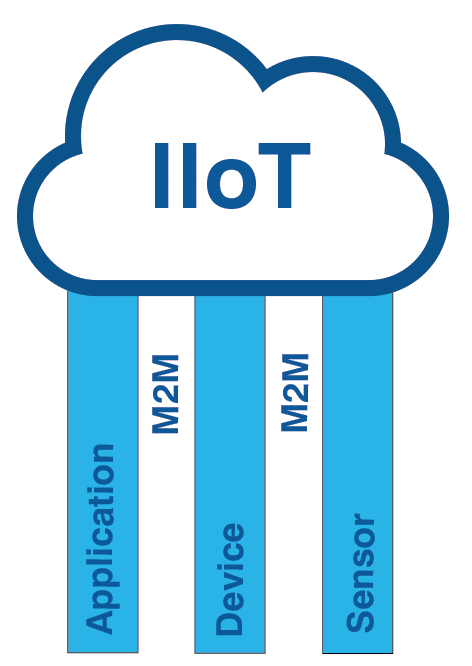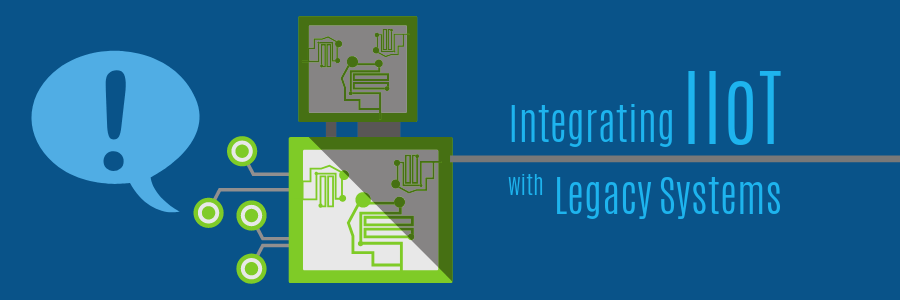As industrial manufacturing companies have continued to increase in size and complexity to meet OEM demands for higher production volume and customization, unexpected machine failures and disjointed business processes started to increase. Manufacturers looking for solutions knew that first and foremost, they needed greater visibility into their operations– especially real-time visibility, which M2M systems can’t provide. Instead of relying on unsatisfactory communications between machines and applications, they turned to IIoT.
IIoT vs. M2M
Chances are, your manufacturing floor already has machine-to-machine (M2M) communications in place. Although M2M is similar to IIoT, the way they retrieve data from machines and communicate is much different. M2M represents the point-to-point connectivity between machines where IIoT is the overarching network of those connected devices. IIoT takes the M2M communication that’s already occurring and integrates it with web applications via cloud whereas M2M just refers to the communication of two physical pieces of hardware.
Because IIoT represents the entire network and is based in the cloud, it’s much more scalable and accessible than M2M systems. Additionally, any insights realized from M2M communications will be out of context by the time you obtain the data since they’re not integrated directly into your back-end business applications. Unlike M2M communications, IIoT offers more valuable business insights as it directly feeds your plant floor data into your business applications, allowing you to make insightful decisions in real-time.

So, manufacturers know they need real-time data, but how to achieve that hasn’t quite been clear due to the widespread existence of legacy systems. When manufacturers implemented these hardware infrastructures decades ago, they were designed to last and be extremely secure. These systems technically haven’t reached end of life yet, but their designers couldn’t predict the need for Internet-connected infrastructures that were to come. The intelligence required to reveal real-time insights isn’t easy to integrate with systems that weren’t originally designed to communicate at all, especially not with a public network. In fact, legacy infrastructures were designed to do quite the opposite: lockdown and secure data to protect it from cyberattacks.
Since manufacturers spend millions on their plant floor equipment, systems and processes, just ripping and replacing new systems for an IIoT–enabled system is out of the question. So how do manufacturers stay relevant and competitive when their legacy systems weren’t built for it?
Start with Building an IIoT team
From a technical standpoint, connecting your legacy equipment to the Internet isn’t nearly as difficult as it used to be. However, since IIoT connectivity requires the involvement of both IT and operational technology, it can be difficult to satisfy both sides of the house. Often times, there’s not a great relationship between the two, due to differing opinions, objectives, and processes. In the past, it’s typically been the operations staff who have managed M2M communications and gathered the data, but IT teams often feel that since it’s a technical implementation, it should satisfy their objectives first.
Consider adding someone with operational expertise to your IIoT team to educate and ensure the OT objectives are being met. This can help IT stay on course and not just focus on logistics like security, connectivity, and other technical issues.
Bring your legacy systems out of 1980 and into 2019 with IIoT
If you’re looking for future-proof, affordable ways to integrate IIoT with your legacy systems without having to rip-and-replace a thing, your best bet is to utilize edge computing. Edge computing fulfills manufacturers IIoT requirement for real-time data since it’s close to the source and scalable.
When it comes to integrating IIoT with legacy systems, many manufacturers are hesitant due to security concerns, but that’s exactly what makes edge computing such a great solution for legacy systems. Leveraging edge nodes, you can easily connect legacy equipment to the “edge” of the cloud and only send outbound data. They don’t create a two-way communication, which would expose the device to the Internet. This makes edge nodes a perfectly secure option. They’re also a great defense for breaches in security because they monitor any and all communications that happen on the network to detect any suspicious activity.
In addition, edge nodes can also translate protocols to connect devices, applications, sensors and more. Because of these capabilities, retrofitting legacy machines with edge nodes is one of the most common ways manufacturers are modernizing their infrastructures for an IIoT world.
Another option that supplement edge nodes are smart sensors. Smart sensors offer real-time data for predictive maintenance and easy root-cause analysis. With built-in intelligence, they can combine different data signals and form conclusions about latent or potential problems. Yes, sensors are nothing new, but the difference with smart sensors for IIoT is that they are more robust, self-diagnostic, self-calibrating and can efficiently perform edge computing capabilities. Integrating smart sensors into your manufacturing environment enables you to get real-time reports to take action quickly to keep your business up and running.
You can rest easy knowing there are ways to enable IIoT for enhanced maintenance efficiency, reduced downtime and lower operating costs without ripping-and-replacing your trusty legacy equipment.
Stay abreast of relevant IIoT topics, tips, update and more. Subscribe to our blog and stay on the cutting edge of connectivity and automation!

